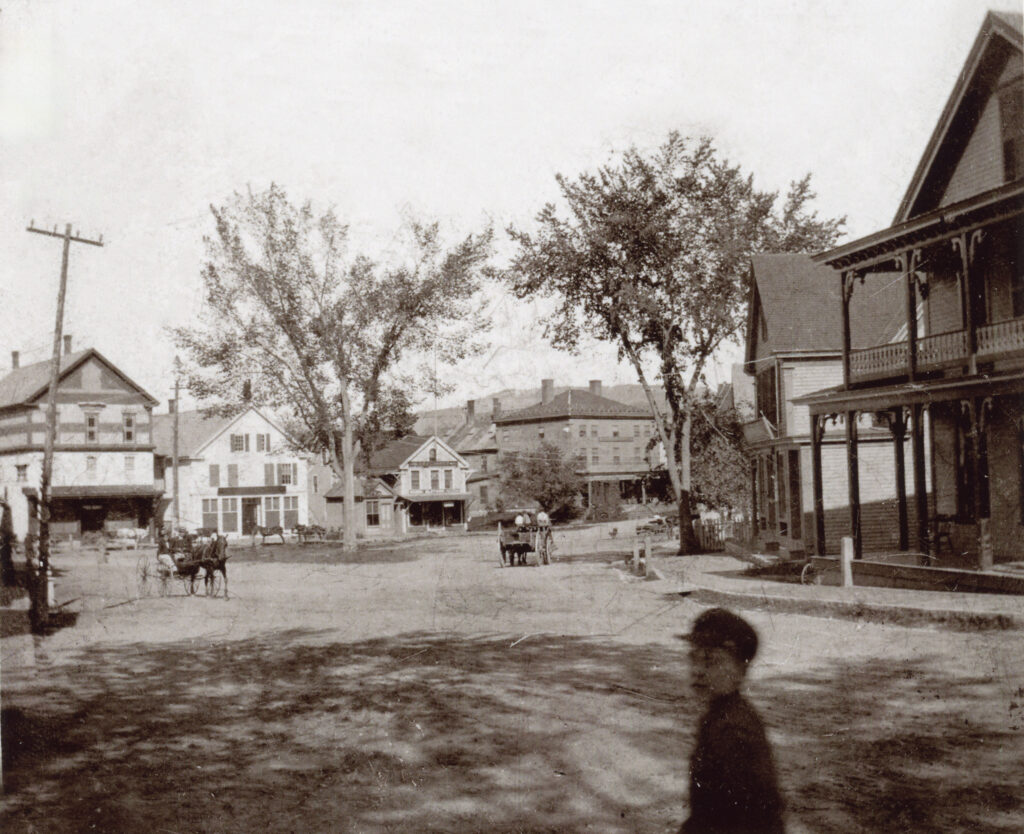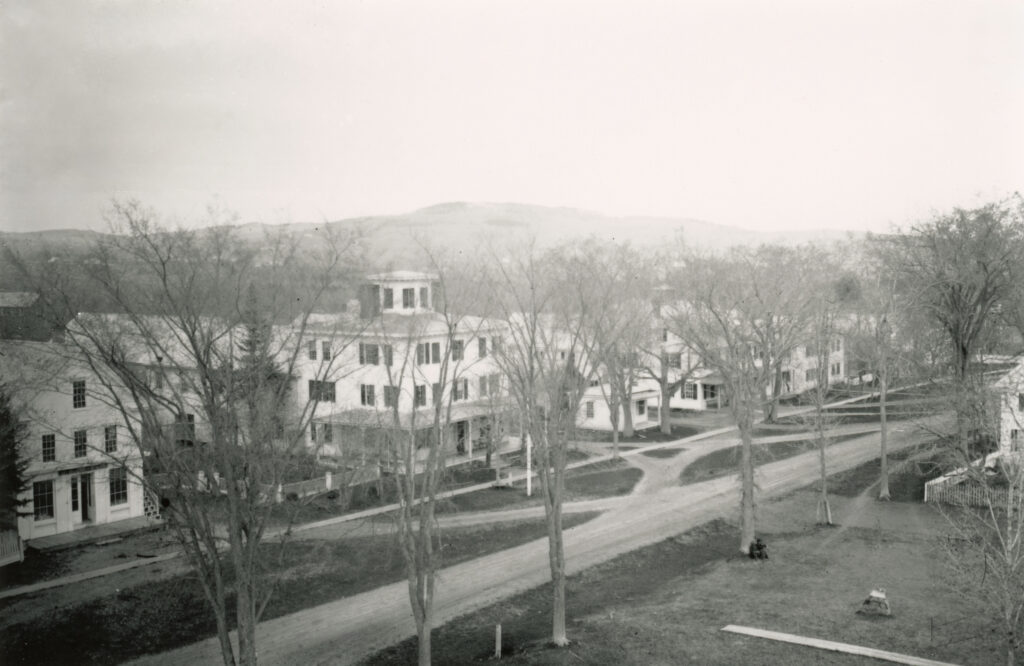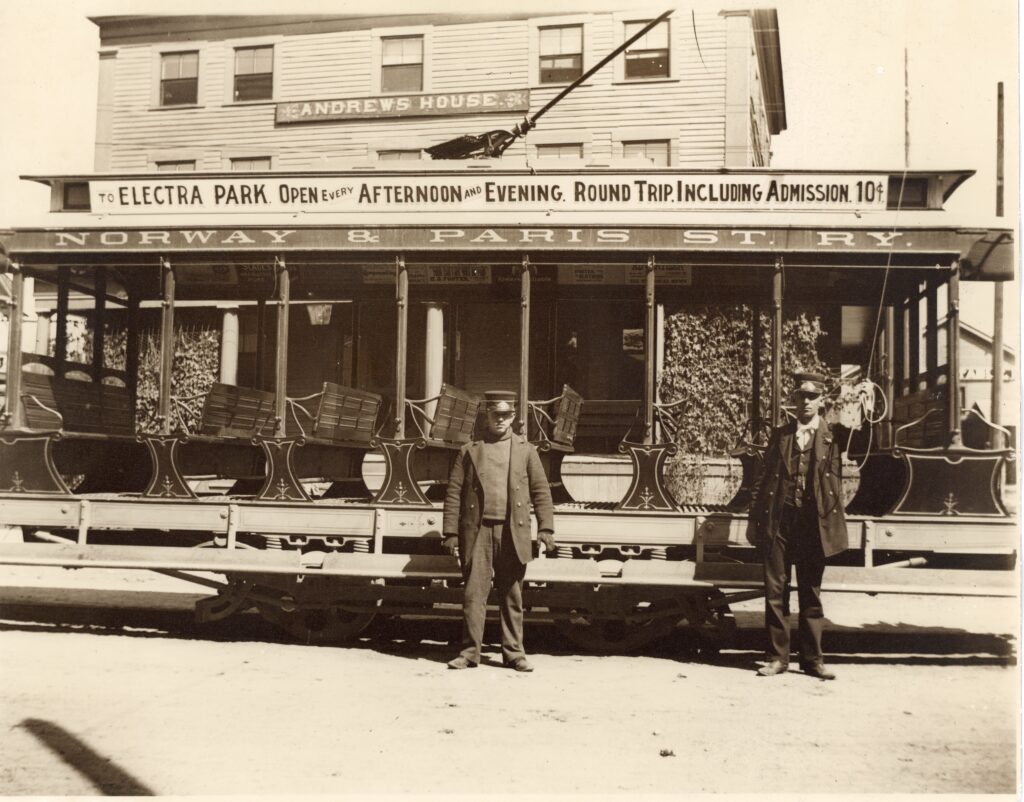History of the Town of Paris, Maine
Paris, the first and only “shire” town there has ever been in Oxford County, was incorporated the 82nd town in the State of Maine on June 20, 1793. It became the shire town of the county in 1805.
On Thursday October 11, 1879, a giant family reunion and centennial observance of the founding of the town was held on Paris Hill which, by the application of simple arithmetic, would show that the town as such had its first beginning in the year 1779. Previous to that there is definite evidence to prove that there was a settlement of a sort which was known and referred to as Plantation Number Four.

Early Records
By rare good fortune the town of Paris at one time chose and elected for one of its selectmen, Silas P. Maxim. One of the most excellent things he did while in office was to overhaul a pile of rubbish that had collected in the corner of the town house. While thus engaged he picked up a page of manuscript which he saw was an old record, and further search and effort on his part produced a volume which when put together proved to be the original record book of the proprietors on the plantation.
This may have been an inspiration to him to make the effort to collect and compile the information and data which stands as a monument to his name and memory today in the History of the Town of Paris.
Original Grant
In 1734, it appears that certain parties petitioned the General Court of Massachusetts for a grant of land as compensation for services in the Canada expedition of Sir William Phipps in 1690. The petition was favorably acted upon, and a grant made in 1736. The original grantees were Captain Samuel Jackson and 59 others.
On March 5, 1739, King George II of England determined the boundary line between the provinces of Massachusetts and New Hampshire which had been in dispute. This decision cut off from Massachusetts the line of townships between the Connecticut and Merrimac rivers, thus rendering the grants from the General Court of Massachusetts, null and void.
The grantees, therefore, had no other recourse but to petition for another grant in lieu of the grant taken from them by the settlement of the above mentioned line.
Townships Granted
Nine townships were granted in 1736 to the officers and soldiers surviving in Canada, which when surveyed and assigned were called Canada Townships. Only two of them, however, were located in Maine: Jay, called Phipps Canada, and Turner, called Sylvester Canada. The first grant is now the town of Keene, New Hampshire. It was supposed to be located in Massachusetts but proved to be in New Hampshire when the lines were run.
After the loss of the township the matter was allowed to rest until 1771, when Captain Joshua Fuller and others received a grant of township in lieu of the loss. The new township was confirmed to them in 1773.
Early Road
The first definite act towards a settlement of any sort was the opening of the road through the township from the southeast corner to the northwest corner. This was in 1779, and this the people regarded as the first occupation of the soil and this was the basis of the celebration of the 100th anniversary. This is the road running from Hebron, over Number Four Hill, by Alonzo King’s to Paris Hill, thence down the hill by the Rawson homestead to Bisco’s Falls (True’s Pulp Mill) and over the hill (High Street) to the Woodstock line.
The town was incorporated very soon after it was settled, the residents taking the management of municipal matters into their own hands. Lemuel Jackson of Middleboro, Massachusetts was a forehanded man for his time and he had a family of grown-up sons. He and his son-in-law, Deacon John Willis, made the first settler’s purchase in December 1779. They doubtless felled trees in 1780, burned them, and raised a crop of corn in 1781, and moved in with their families in 1782.
The first boy born in town was Joseph Daniels, the second, a son of Asa Barrows, Priscilla Willis and Sally Stevens were the first girls born in town, but the uncertainty always clinging to the age of a lady makes it impossible to determine which was the older.
There is an old wives’ tale which claims that the greater part of Paris Hill was sold at one time for an iron kettle, but Silas P. Maxim was inclined to treat the story as a myth. John Daniels felled the first trees in town. He was a squatter on the land of Lemuel Jackson. The latter paid him for the improvements he had made, when daniels took up the farm afterwards occupied by Deacon Joel B. Thayer.
Following the incorporation there was a gradual, healthy development of the town, but due to the limited means of transportation and communications, the expansion was a necessity comparatively slow as judge by our modern standards.
Paris Hill
The village of South Paris, as such, had not come into existence except for a portion of the section east of the river and the present Hill Street, there being more houses at that time in the east-of-the-river section than in the entire west-of-the-river section.
The center of population was Paris Hill. Having been selected as the shire town of Oxford County, the court house and jail and county offices were located there and continued there until the present courthouse was built in South Paris in 1895.
The newspaper was printed “on the hill” and the Paris Manufacturing Company plant was first located there. With the development of the water at Stowell’s Mills and the building of the bridge there, that section of town began to grow.
Probably the greatest contributing facto to the development of the South Paris Village area was the building of the Atlantic & St. Lawrence Railroad (Grand Trunk or Canadian National). This happened around 1850 and the terminal or “rail head” was located at South Paris. As was to be expected, the settlement of population began to concentrate on the line of the railroad.
At one time there was quite a concentration of population in the Bolster and Robinson district and Brimstone Corner. The Congregational Church was the first located there and the schoolhouse was also in the area. As a matter of fact, for quite a number of years the school children of what was then the South Paris Village area had to travel the mile and one-half or so distance to the Number One Bolster District schoolhouse.
The so-called Stowell’s Mills at the east end of the Billings Bridge was originally built as a woolen textile manufactory, but eventually became a flour and grist mill. The lower or down-river half of the long building was occupied by the Mason Manufacturing Company when they first came to town and they continued there until the big fire of 1906 at which time the building was entirely destroyed. After the fire, the Mason Company bought, cleared, and rebuilt a bigger factory on the lot on Pine Street where the present A. C. Lawrence Tannery is located.

Electric Trolley
There was probably always at least one shoe factory located in Norway and this had provided lucrative employment for a great number of people over the years.
At first, the South Paris people who were employed there were conveyed by horse-drawn stages or carriages up to the year 1895, when the electric trolley line was built and put into operation. ?This ran from a point near the outlet to the lake in Norway to a point opposite the hotel which is the present Andrew’s Nursing Home.
There was a switch and turn-out located nearly opposite the Fairgrounds so that more than one car could be operated at the same time. Power was furnished by an overhead wire through a trolley arm which had to be shifted at each end of the route.
It furnished a very satisfactory method of transportation for the general public up until about 1919, when the advent and popularity of the automobile caused it to be abandoned. Many of the men who served as operators remembered by the older citizens for their courtesy and kind consideration.

For a long time the largest and possibly most important business establishment in South Paris Village was New Hall or Odd Fellows Block and affiliated bodies.
The Ripley & Fletcher Company had its inception in this building as Herbert G. Fletcher (the father of Harold Fletcher) who had conducted a barber shop for years in the building formed a partnership with Perley F. Ripley and what was later to become the Ripley & Fletcher Company started there.
The administrative affairs of the Town of Paris were handled by a board of three selectmen up until 1960 at which time it was voted to enter into the town manager form of government.
In 1957, a division of the town was effected, the former village of West Paris having petitioned the state legislature and having been granted authority to become a town in their own right. In both cases the current arrangement seems to be working out satisfactory for all concerned.
In view of the numerous and radical changes of even the past decade it can only be with a spirit of trepidation that we gaze into the crystal ball and endeavor to conjure what it has in store for us.
At the same time we can only marvel at the founding fathers that they had the courage of their convictions and were able to face up to each situation as it was forced upon them.



